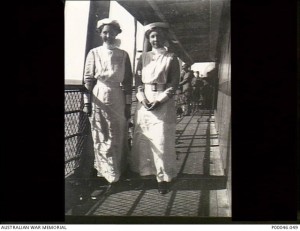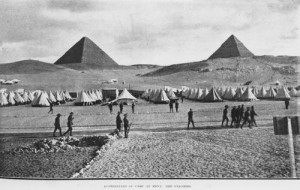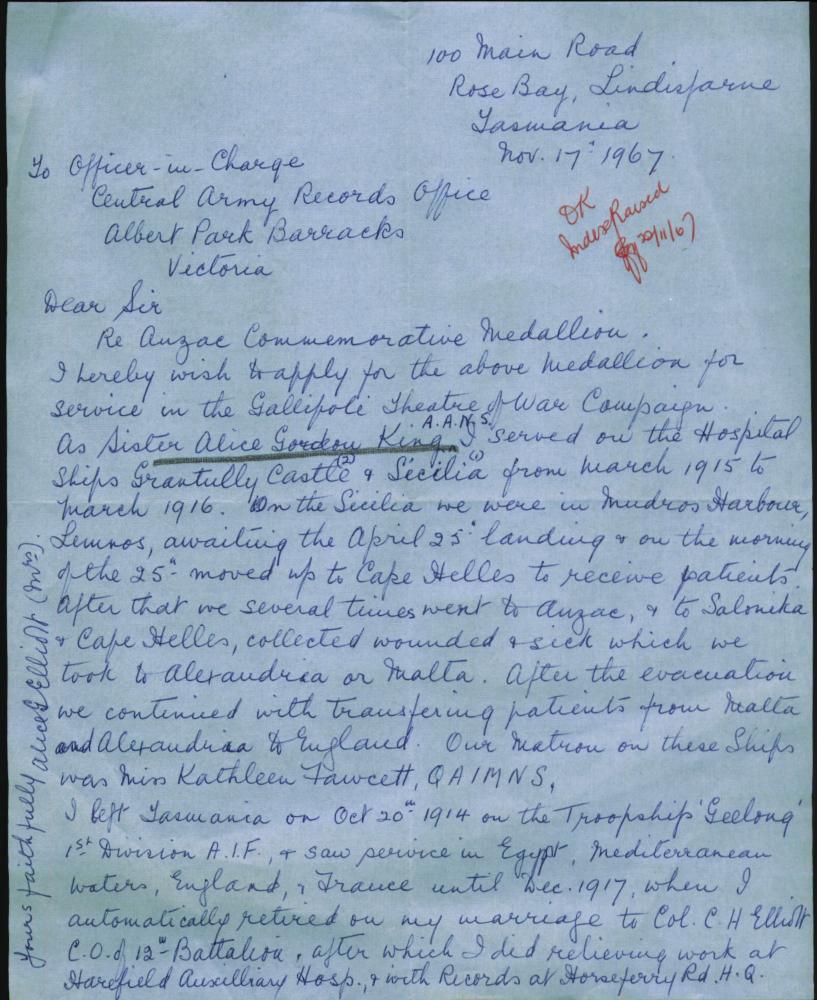Two brave WWI nurses from Tasmania

GOODBYE HOBART TOWN
On October 20 1914, the 12th Battalion AIF embarked from Hobart on the troopship Geelong. They were accompanied by two Australian army nurses; Sister Alice Gordon King (left in the picture below) and Sister Janet Ella Radcliff (right).
Alice was 28 years old; a pretty brunette with grey eyes. She was above average height, but very slim, weighing only eight stone. Janet was 31, and an inch or two shorter than her friend.
On board ship they assisted the Regimental Medical Officer, Captain Victor Ratten. There was plenty to do; vaccinating the men against diseases such as cholera and typhoid, relieving the misery of seasickness, and helping to train medical orderlies. At Albany in Western Australia, the Geelong joined a convoy carrying 30,000 Australian and New Zealand troops to Egypt, and ultimately to the battlefields of Gallipoli and France. The fleet left on November 1st; All Saints Day. Considering the selfless sacrifice of so many, that date is very poignant.
When the conv0y arrived in Alexandria, the 12th battalion was transported to Mena, in the shadow of the great pyramids.
There was little time for sightseeing, especially for nurses. On their trips to Cairo obtaining equipment for the new field hospital, Sisters King and Radcliff also made time to procure much needed mosquito nets for the men of the 12th, who were housed in tents. Unfortunately, training in hot weather followed by cold nights led to early casualties. The hospital at Mena soon filled with pneumonia cases.
Eventually, orders came for the Anzacs to sail for the Dardanelles. The Tasmanian nurses left Egypt soon afterwards. They first served aboard the hospital ship Sicilia, moored off Anzac Cove to receive the wounded in the horror filled hours and days following the landing. From the Sicilia they moved to the Grantully Castle, and over the next few months they spent long hours tending men being moved to hospital on Malta, or repatriated back to Egypt
Subsequently they were transferred to France, for service at No. 2 Stationary Hospital at Abbeville. In August 1917, Alice was posted to a casualty clearing station in Belgium. She became Temporary Head Sister, treating casualties arriving in waves from the fierce battles near Passchendaele.
A WARTIME ROMANCE
While on leave in London just before Christmas 1917, Alice married Lt. Col. Charles Elliott. Elliott had sailed aboard the Geelong as a Captain, but after the death of senior officers at Gallipoli, he had become Commanding Officer of the battalion. It was understandable that the couple wanted to marry. Charles would soon be returning to France and his chances of survival were not high. Sadly, army regulations meant that Sister King was forced to resign from the A.A.N.S. immediately. What a tragic waste of experience and devotion to duty. To her credit she continued to help wherever and in whatever role she could; at Harefield Auxiliary Hospital (where many wounded Australians were treated) and at Army Headquarters in London. Despite this, on April 5 the following year she signed a form forfeiting her right to a free passage home to Australia. Lt. Col. Elliott was shot in the arm and chest during the fighting in France, but thankfully he survived. He was awarded the Distinguished Service Order and Bar, and the Conspicuous Gallantry Medal. He was also one of 19 Australians (and the only Tasmanian) to receive the French Légion d’honneur.
COURAGE UNDER FIRE
Sister Janet Radcliff was mentioned in dispatches in September 1916, for her hospital work under dangerous conditions at Abbeville. She finally returned to Tasmania in March 1919, discharged due to ill-health after serving throughout the war. When it was offered, she applied retrospectively for an £8 Warm Clothing Allowance. The payment was to cover garments she had purchased during her time in France. On November 22 1921, after numerous letters back and forth, she received the following response from the Army District Finance Office in Hobart;
‘With reference to your application for the Warm Clothing Allowance, I have to advise you that I am in receipt of advice from our central office, to the effect that as you were not in France during the winter of 1916-1917 your claim has been disallowed’.
Janet died the following year, aged 39. An obituary published in the Illustrated Tasmanian Mail (December 14, 1922) paid tribute to her extensive war service, noting that it had been the cause of her premature death:
‘Miss Janet Radcliffe [sic] did long and strenuous work, leaving Tasmania in the first months of the great struggle, and did not return until it was over. She so overtaxed her strength that she returned quite broken in health. All hoped for a continuance of her busy, useful life, but it was not to be. Sister Janet Radcliffe is one more of the gallant war-workers whose life has been given for the cause’.
A treasured item passed down through Janet’s family is a brass dish, fashioned from a bomb shell by one of the diggers she had cared for. Its simple inscription reads;
To Miss Radcliff from your friend 25/12/18
Despite her husband’s serious war wounds, Alice enjoyed a happy post-war life with Charles. In the years ahead they raised a son, and were both very active in an association formed to remember the 12th Battalion. It was known as, THE OLD ORIGINALS. After Janet Radcliff died in 1922, Alice contributed to a memorial honouring her friend. In 1967 she successfully applied to be awarded the Anzac Commemorative Medal. In a letter to Base Records in Victoria she outlined her wartime service at Gallipoli;











 Proudly Australian owned and operated
Proudly Australian owned and operated